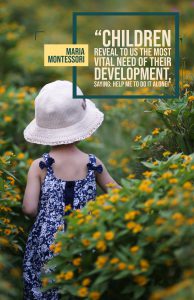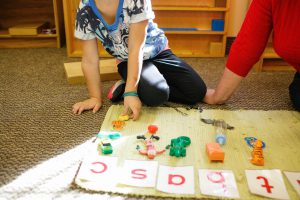What Makes an Authentic Montessori School?
February 16, 2022Montessori and the Whole Child
March 8, 2022Toddlers are famous for their struggles with transitions: That’s why they melt down when it’s time to stop playing and start the bedtime routine, and it’s why tools such as timers and 5-minute warnings are so useful. It’s also why you may be concerned about your child moving from a toddler program into a preschool program. But don’t fear! We are experts at helping children move smoothly into our preschool program, and we can also help you know when it’s time to make the change.
Signs of Readiness
Before we move a child from our toddler program into our preschool program, there are a few things our teachers monitor for:
 First, the child must be completely toilet trained. This means that the child must be able to urinate and have a bowel movement in the toilet and attempt to wipe their own bottom. The child must be able to ask to use the bathroom (or be able to go on their own), and they should be able to pull their pants up and down on their own. The preschool classrooms have stalls, so children will have more autonomy over their bodies. Teachers will only enter the stall if a child requests assistance.
First, the child must be completely toilet trained. This means that the child must be able to urinate and have a bowel movement in the toilet and attempt to wipe their own bottom. The child must be able to ask to use the bathroom (or be able to go on their own), and they should be able to pull their pants up and down on their own. The preschool classrooms have stalls, so children will have more autonomy over their bodies. Teachers will only enter the stall if a child requests assistance.
Second, our teachers will look to see if a child shows social and emotional maturity. These can include working well with others, communicating effectively, staying on task, developing grace and courtesy toward others, and connecting with peers. They also involve developing self-awareness and emotional control. We don’t expect children to have mastered all these skills, but our teachers do look to see how they are developing.
Finally, children must be at least 33 months of age before they can transition to preschool.
What You Can Expect In Our Preschool Program
Many things will stay the same when your child transitions to preschool: They will still be with highly trained and loving teachers, and they’ll still be receiving an authentic and high quality Montessori education. That said, there are some differences in the preschool program, aside from it being more challenging.
The ratio of caregivers to children is 1:4 in the toddler rooms and is closer to 1:10 in the preschool rooms. This means that children will not get quite as much individualized attention, and so children will work on becoming more independent. They will need to learn to communicate their needs effectively as teachers have more children they need to care for.
Children will also need to work on being self-directed and able to make choices as free-choice work-time is for a full two hours. Our preschool rooms are also larger and contain many more materials available on the shelves.

Ways to Ease the Transition
Our caring teachers will work hard to make the transition to preschool as smooth and painless as they can. We are incredibly responsive and sensitive to children’s emotional needs and will, of course, meet children where they are. Prior to the end of their last toddler year, our toddler and preschool teachers will work together to acclimate them to their new room. This will involve the preschool teacher visiting the child in the toddler room, and the child visiting the preschool teacher in their room.
You can help ease the transition too. Be sure to talk with your child about how they will be joining a new class and what that means for them. You can read books about starting preschool or about having a new teacher. If your child likes, try some role playing—you be the new student who is nervous and have them be the new teacher, and then you can switch roles. Let them direct you in what to do or say if they want. This will help them work through any worries or concerns they have.
Another thing you can do to help with the transition is have children attend even just one month in the summer if possible. This will give them a chance to get to know their new teachers and classmates in a slightly more relaxed environment with lots of outdoor play and summer fun. When the fall program begins, they will be ready for and comfortable with the change!
Still Have Questions?
The transition to preschool is a big change for both your child and you! If you’d like to talk with us more about it, we’re happy to help. Send us a message or give us a call anytime.